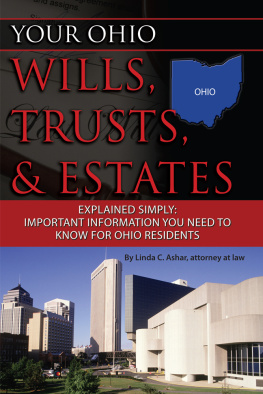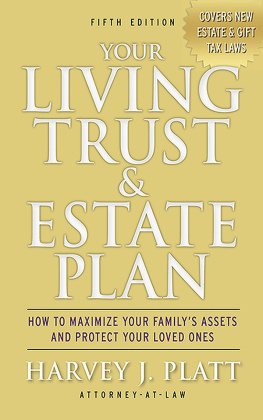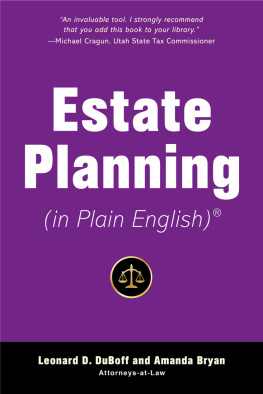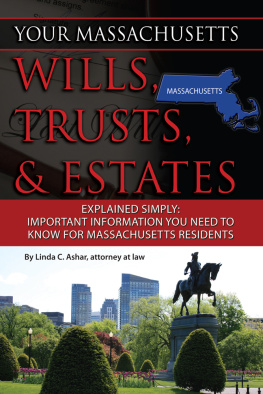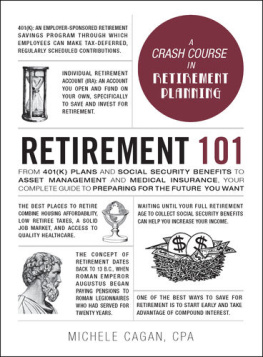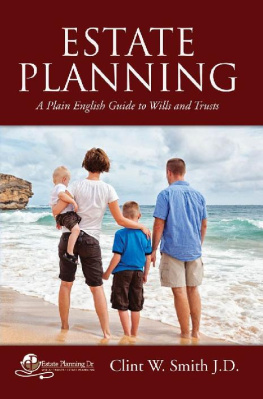Praise for How to Plan and Settle Estates
Law attorney and certified public accountant Fleming adds a new title to the arsenal of resources on estate planning. Presenting the process as a series of decisions to be made, he methodically provides the information needed to make them. Fleming covers wills, trusts, income and estate taxes, powers of attorney, and the responsibilities of executors and administrators. Each chapter begins with a points to consider section containing practical tips, observations, and numerous checklists to help readers assemble documents and understand processes. The appendixes include sample wills, powers of attorney, living trusts, a glossary, and a directory of information sources this book is good preparation for a meeting with estate-planning professionals.
The Library Journal
Coping with the loss of a loved one is beset with stress and confusion. Grief is a heavy burden, yet most families are further saddled with the responsibility of administering the estate. For those who find themselves in this situation and for those who wish to shield loved ones from it, How to Plan and Settle Estates is a comprehensive guide for making this subject as simple as possible. The book covers the steps to developing an estate plan, tax issues, federal requirements, and sample forms to fill out, and includes checklists and examples. The author is a CPA attorney specializing in real estate and estate planning.
Working Money


I would like to dedicate this book to my wife, Fran, who spent countless hours proofreading the manuscript and provided valuable insight and many suggestions for the book. Also, to my three wonderful daughters, Therese, Katie, and Patricia, who think it is kind of cool that their dad wrote a book .

This book is designed to provide a general overview of basic estate-planning principles and the administration of estates for non-lawyers or lawyers who do not practice in this area frequently. References to he or she in this book should be read as pertaining to either gender. The author and publisher have attempted to provide the most accurate and up-to-date information available. The information contained herein cannot be guaranteed and neither the author nor publisher will be held liable for any action at law or in equity based on this book. There are too many exceptions, changes, and gray areas in the laws to cover every issue. The purpose of this book is to provide an awareness of issues and techniques that will allow the reader to ask the right questions of their attorney, accountant, certified financial planner, insurance agent, trustee, or other professional advisor. Neither the author nor publisher is engaged in rendering legal, accounting, tax, financial planning, or other advice.
TABLE OF CONTENTS
APPENDICES
The American Tax Relief Act of 2012
P resident Obama signed into law in January, 2013, the American Tax Relief Act of 2012, Public Law 112-240, (ATRA). Without this law, many income and estate tax provisions would have been changed to the detriment of taxpayers. The top Federal estate tax rate would have reverted to 55 percent, with an exclusion amount of $1 million. The ATRA provides for a maximum rate of 40 percent, with an exclusion amount in 2013 of $5,250,000 (indexed for inflation.) The ATRA also made the portability provision permanent, which allows one spouse to use the unused exemption of the deceased spouse. The ATRA also repealed the 5 percent surtax on estates over $10,000,000.
Foreword
I first became interested in the field of estate planning while employed by the Internal Revenue Service. I read various books on estate planning and attended free seminars sponsored by a range of organizations. It seemed most estate planners were concerned with: (1) helping me avoid probate with living trusts; (2) sheltering $1,500,000 in property from estate taxation (which I do not have); or (3) wanting me to become their client and invest in mutual funds and buy insurance. While these are significant issues, they are not the only issues in estate planning.
After leaving the Internal Revenue Service, I began assisting executors and administrators with estates. I found there were few, if any, books that I could recommend to guide them through the process. Similar books are too detailed to comprehend in the short time frame allowed or too general to be of any real assistance.
Although this book often cites Illinois law, many state laws are similar. Since there are variations in each state, and laws are constantly changing, the reader is advised to check with an attorney familiar with her states laws prior to drafting an estate plan or administering an estate. Also, while the federal laws discussed in this book are applicable to each state, some federal laws rely upon the property law of that particular state in their calculations and interpretations, especially community property states. For example, the Medicaid laws and regulations, although based on federal law, will vary from state to state, since each state administers the program subject to the federal guidelines.
Each person is advised to seek the advice of a competent estate-planning attorney for his specific needs. (In writing this book, I treat the terms he and she interchangeably.) It is the readers responsibility to make sure the facts and laws discussed in this book are applicable to his situation. I hope readers understand that each topic discussed could have its own book. Hopefully, this book will give users a sufficient awareness and general understanding of the issues involved to ask the right questions of their attorneys or other professional advisors.
E DMUND T. F LEMING
In accordance with IRS Circular 230, any tax advice in this book is not intended or written by the author to be used, and cannot be used, by a person or entity for the purposes of 1) avoiding penalties that may be imposed on a taxpayer, or 2) promoting, marketing, or recommending to another party any matters addressed within this book. This book is intended to provide an awareness of issues that you may wish to discuss with your tax advisor or accountant .
Key to Sources Cited
T his text refers to many IRS publications, which you may want to access. Use this key to find out what type of publication is cited and where it can be found. Remember also that IRS information (and forms) can be found at www.irs.gov .
| IRC | INTERNAL REVENUE CODE TITLE 26 |
| This is the federal income and estate tax code, available at most libraries. |
| CFR | CODE OF FEDERAL REGULATIONS |
| These are laws promulgated by agencies within their authority, available at most libraries. |
| PLR | PRIVATE LETTER RULING |
| This is advice given by the IRS to a taxpayer on a given set of facts. A PLR may not be cited as precedent, but gives taxpayers an idea of how the IRS views a particular set of facts. It is available on Lexis, also Commerce Clearing House IRS Letter Rulings Reporter . |
| TAM | TECHNICAL ADVICE MEMORANDUM |








